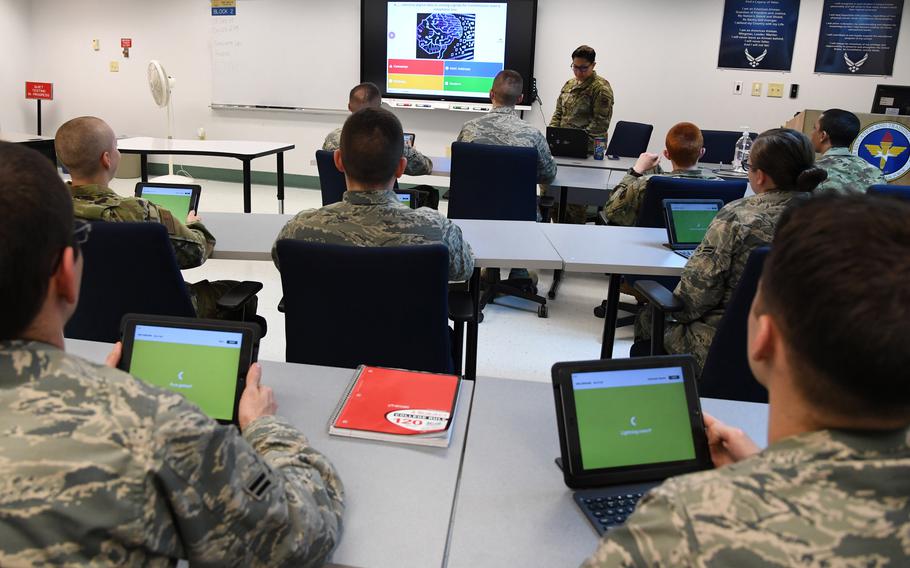
Students in the 333rd Training Squadron use tablets for training during the information technology fundamentals course at Keesler Air Force Base, Miss,. in December 2019. (Kemberly Groue/U.S. Air Force)
The Air Force is ditching textbooks in basic training in favor of iPads in an effort to keep up with recruits used to having mobile devices constantly in their hands and limitless information at their fingertips.
“When we hand them a book, it’s foreign to them,” Marilyn C. Holliday, a spokeswoman for Air Education and Training Command, said in a recent phone interview.
Officials also found that adopting modern digital technology in basic training could slash study times while avoiding the costs and complications of printing some 35,000 textbooks issued each year.
This month, the 737th Training Group plans to begin phasing in the first of some 6,000 Apple iPads to replace traditional paper materials at the service’s basic military training at Joint Base San Antonio-Lackland, Texas, Holliday said via email.
It’s part of a broader push to adapt the Air Force to the demands of modern warfare, and quickly. But procurement of tablets was delayed by the pandemic and related supply chain issues, officials said.
At the same time, the cost of the “pallets and pallets” of paper needed for the printed texts each year has risen sharply amid the COVID-19 outbreak, they said.
Printing costs normally run about $100,000 each year, Holliday said in an email in late March, but she did not give a figure for the increase during the pandemic years.
The iPads won’t be issued for keeps. They will be collected at the end of each training cycle. Their use eliminates the need for printing and streamlines the process of revising course materials, officials said.
New recruits in BMT need to learn a variety of things, such as tactical combat casualty care, fieldcraft skills and doctrine. In all, there are some 107 modules of instruction for each seven-and-a-half-week BMT training cycle.
That’s “pages upon pages of text,” upward of 500 pages, some of which may need to be revised several times a year, said Brian Bulley, training manager for the 737th. Revisions and reprints can take weeks.
“There has to be a better way,” he said. “We have to be more agile in what we do.”
Other Air Force training units also have begun modernizing their courses or delivery methods, making greater use of simulators, artificial intelligence and hybrid, online and distance learning.
The 37th Training Group, part of the same wing as the 737th, is redesigning its real-world classrooms with technology and furniture that reflect a focus on small-group collaboration, said Col. Joyce Storm.
“Think bean bag and pod chairs versus old school tables, desks and chairs,” Storm, the group’s commander, said in a February statement.
Students at the Defense Language Institute in Monterey, Calif., have been issued iPods or iPads for more than a decade. Earlier generations were weighed down with a dozen or more workbooks and stacks of audio cassettes.
The 737th began exploring the application of similar tablets under a 2019 research and development agreement for use of online adaptive learning software from San Diego-based Cerego. The Air Force also awarded an $81,000 contract to the firm for software licenses last year.
Something like a virtual tutor, the software has a built-in algorithm that gives trainees reminders, helps them review material, tests retention and adjusts training to focus on areas where users might be weaker.
Some 108 trainees at BMT in 2019 were issued the devices as part of a “beta-test,” which found that the software helped reduce the time airmen spent studying by 56%, Bulley said.
Instructors found it helpful for identifying people who needed more help, while curriculum designers found that it let them change course materials about 30% faster than the traditional textbook did, he said.
That means airmen retain more, while the service ensures that the information is the most current and relevant available, Bulley said.
The entire Lackland training campus has already been outfitted with Wi-Fi so trainees can access course materials from anywhere, and all 107 modules of the training curriculum are available online.
Officials hope to fully roll out the tablets to all of the group’s training squadrons by year’s end.